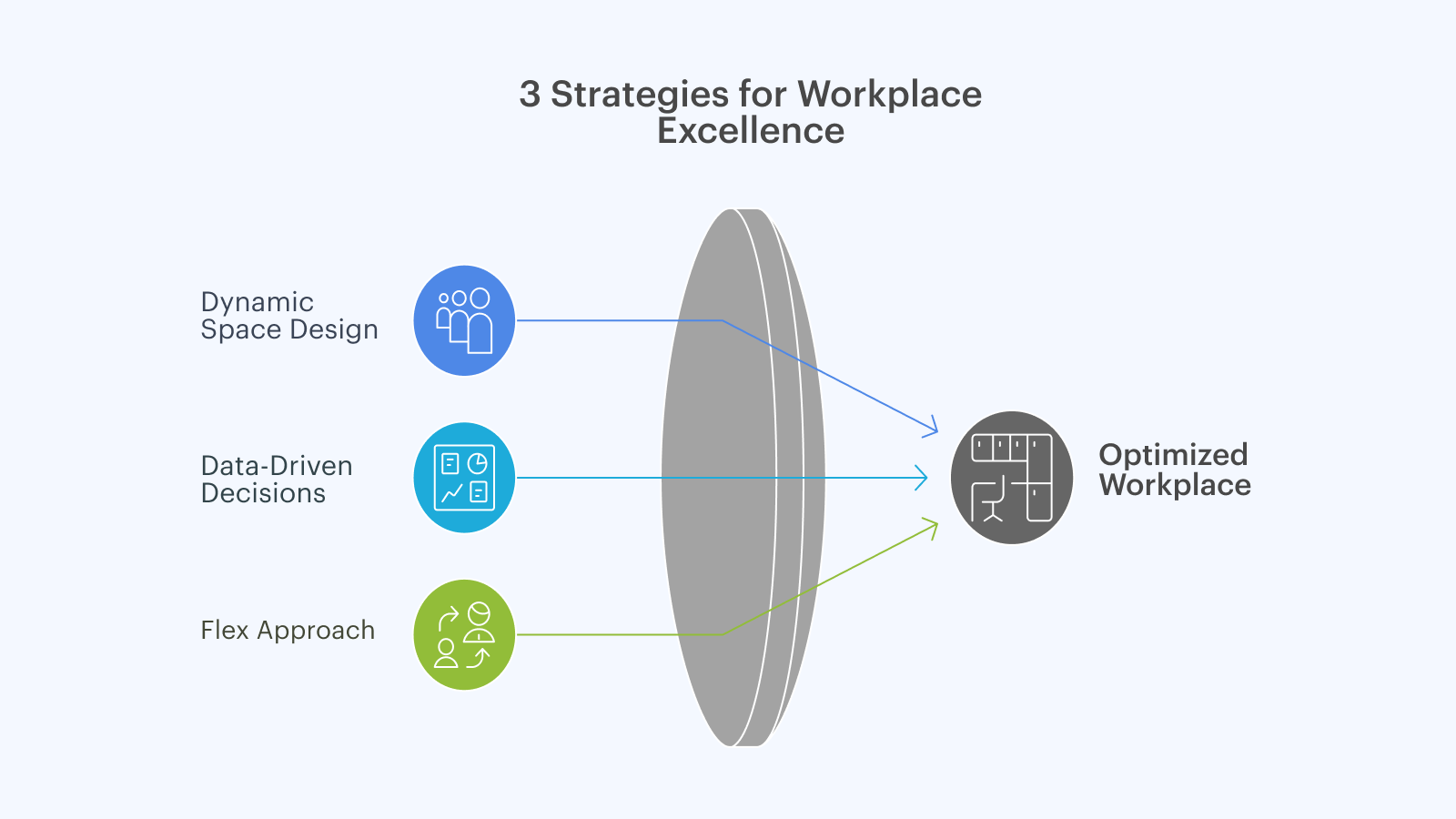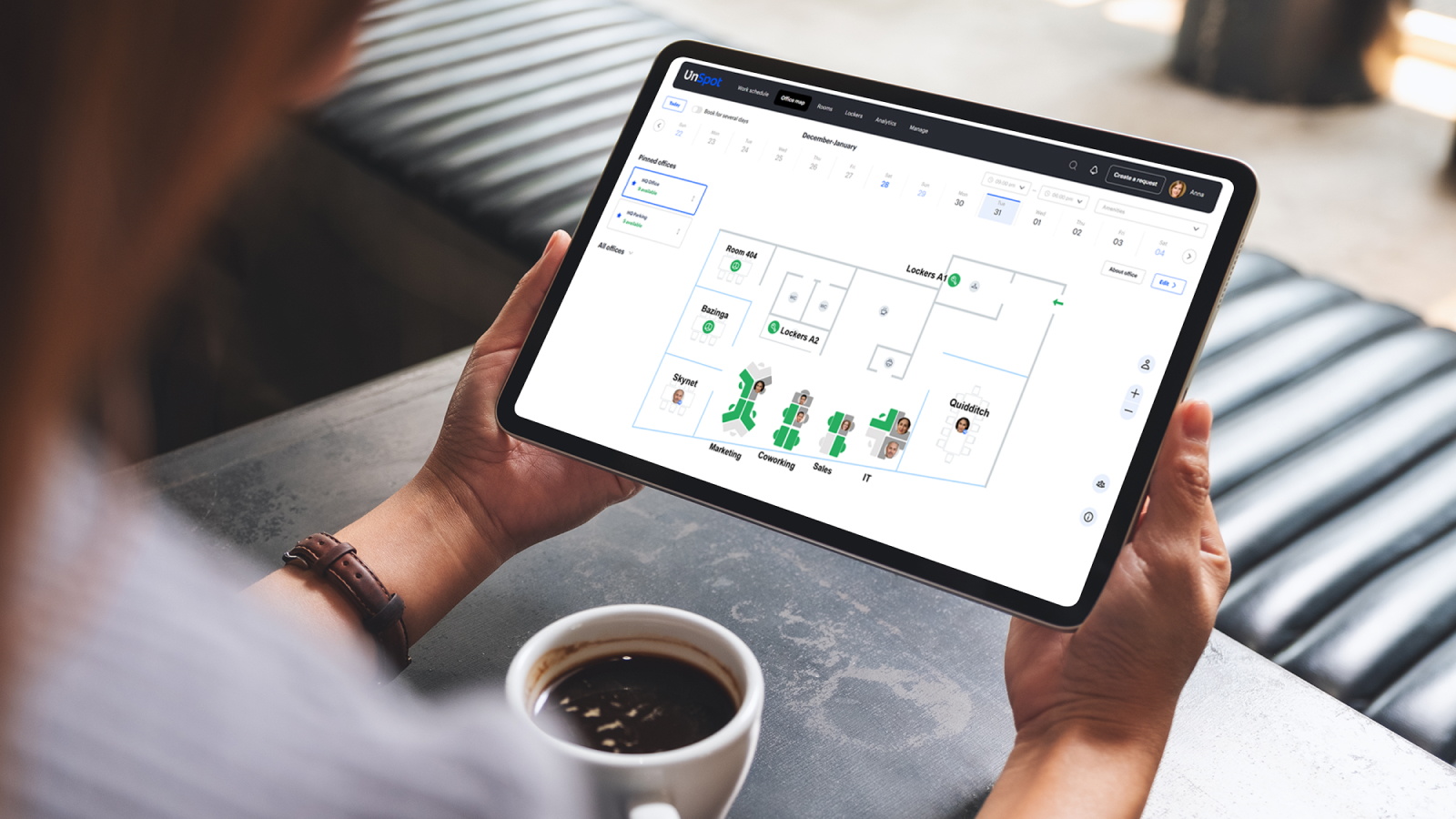In today’s rapidly evolving business environment, work models are transforming. Traditional office setups no longer meet modern employee expectations. Hybrid and remote work demand rethinking everything — from technology to workspace design — with real-time collaboration tools, AI-driven solutions, and robust data security measures setting new benchmarks.
This article reveals key trends for 2025, offering insights and practical strategies to optimize the workplace, empower diverse talent, and ensure a resilient future of work.
The Rise of Hybrid Work in 2025: What Employees Want
In a rapidly changing labor market, hybrid work is no longer a temporary trend, but a strategic shift to meet today's demands. As we approach 2025, organizations are rethinking their work models in an effort to provide the best of both worlds:
- Office collaboration
- The efficiencies of work from home
Key elements of hybrid work
- Work flexibility: Employers are prioritizing the ability to customize schedules, allowing employees to plan their own workday.
- Increased employee engagement: Flexible working conditions increase engagement by satisfying the need for a balanced approach.
- Matching business needs: Each hybrid work model is designed with practical examples and evolving business needs in mind.

Zoom study data
Zoom conducted the research by surveying more than 600 IT executives and C-level executives, as well as nearly 1,900 knowledge workers around the world. Here are the key insights from the study:
1. Adoption of the hybrid work model:
- 64.4% of large companies have already adopted a hybrid model.
- 18.6% of organizations work exclusively remotely.
- 17% of companies continue to stick to traditional office models.
2. Adapting corporate policies: Employers offer models in which 40% to 60% of employees work remotely and spend the rest of their time in the office.
3. Impact on employees: 33% of employees believe that the ability to choose where and when they work improves work-life balance, reduces stress and increases motivation.
AI and Hybrid Work: Real-Time Tools
In the era of AI-driven innovation, real-time tools are reshaping how teams perform within a dynamic framework of hybrid work. As organizations step into 2025, advanced technologies bridge physical and digital workspaces, empowering staff by providing instant insights that enhance communication and decision-making. In fact, many employees want environments where intelligent systems complement human expertise, ensuring smooth transitions between virtual collaboration and on-site meetings.
Key Benefits of AI-Driven Real-Time Tools
- Enhanced Communication: Instant insights and automated data analysis.
- Improved Decision-Making: Rapid access to critical information.
- Seamless Collaboration: Smooth transitions between virtual and physical interactions.
- Greater Work Flexibility: Tools that adapt to evolving team needs.
Comparison Table: Traditional vs. AI-Enhanced Workflows
| Aspect | Traditional Workflow | AI-Enhanced Workflow |
| Project Tracking | Manual updates and periodic reviews | Real-time tracking via AI dashboards |
| Resource Allocation | Fixed schedules and allocations | Dynamic, data-driven adjustments |
| Employee Engagement | Limited by static tools | Boosted through instant insights and feedback |
| Decision-Making Speed | Slower, iterative process | Rapid, informed decisions using real-time data |
Workplace Optimization: Rethinking Office Spaces for Hybrid Work
As hybrid work reshapes the modern workplace, companies are rethinking their traditional workspace to create environments that truly serve distributed teams. The era of uniform layouts is giving way to dynamic designs, where an intelligently planned office space can be adjusted to meet various needs.
3 Key Strategies for Workplace Optimization

Dynamic Space Design
- Transform large meeting rooms into multiple breakout areas
- Use modular furniture to reconfigure spaces quickly
Data-Driven Decisions
- Utilize occupancy data to identify when and where employees are most active
- Adjust workspace design based on usage patterns
Flex Approach
- Redesign layouts to support both creative brainstorming and quiet work sessions
- Balance open collaborative areas with individual focus zones
Comparison: Uniform Layouts vs. Dynamic Designs
| Aspect | Uniform Layouts | Dynamic Designs |
| Flexibility | Fixed and static | Adaptable to various needs |
| Collaboration | Limited, less conducive to teamwork | Enhanced, encourages team interaction |
| Efficiency | Often underutilized space | Optimized based on occupancy data |
| Employee Satisfaction | May not address diverse work styles | Supports creative brainstorming and focused work |
Remote Work and Data Security: Protecting Sensitive Data
As remote work expands, companies face the dual challenge of maintaining a secure digital workplace while meeting rising employee expectations. Cybercriminals increasingly target proprietary systems, leveraging AI techniques to exploit vulnerabilities and compromise data integrity. This evolving threat landscape underscores the need for robust cybersecurity measures that adapt to a distributed environment.
Key Strategies to Safeguard Sensitive Data
- Comprehensive Security Solutions: Organizations must implement security measures tailored to their operational needs.
- Clear Policies and Best Practices: Establish guidelines for data handling and access control to prevent unauthorized access.
Comparison: Traditional vs. Modern Security Approaches
| Aspect | Traditional Security | Modern Security Approach |
| Environment | Centralized systems | Distributed digital workplaces |
| Policy Framework | Basic guidelines | Comprehensive, clearly defined policies |
| Threat Detection | Manual monitoring | ai-powered, proactive vulnerability detection |
| Risk Mitigation | Reactive measures | Targeted strategies to preserve trust and ensure growth |
Employee Expectations: What Companies Must Deliver in 2025
Looking ahead to 2025, evolving employee expectations are transforming the workplace. Today's talent demands flexibility and efficiency, making remote work essential. Employees expect companies to leverage advanced technologies like AI and real-time analytics to streamline processes and drive innovation.
Meanwhile, protecting sensitive data is crucial. With digital threats on the rise, organizations must adopt robust security measures, effective cybersecurity strategies, and clear policies to regulate access and ensure compliance. Balancing technological progress with stringent safeguards builds trust and enhances overall productivity.
Key Focus Areas
1. Flexibility & Innovation:
- Remote work integration
- Use of AI and real-time analytics
- Adaptable work schedules aligned with team dynamics
2. Security & Compliance:
- Robust security measures
- Effective cybersecurity strategies
- Clear policies for access control and regulatory compliance
Real-Time Collaboration and Productivity in Hybrid Work Models
As hybrid work becomes the norm, seamless real-time collaboration is essential for maintaining productivity and meeting employee expectations. With teams distributed across various locations and time zones, employees expect digital tools that replicate the ease of in-person interactions while offering enhanced work flexibility.
Many companies now rely on AI-powered platforms — such as Microsoft Teams, Slack, and Google Workspace — to streamline communication and automate routine tasks. These tools provide several key benefits:
- Streamlined Communication: Real-time updates and integrated chat functions reduce delays and miscommunications.
- Cost Efficiency: Automation and reduced need for physical meetings contribute to lower operational expenses.
- Increased Flexibility: Dynamic scheduling and adaptive workflows allow employees to adjust their routines seamlessly.

Key Takeaways
In 2025, the modern workplace is undergoing a transformative shift. A balanced model of hybrid work has emerged, fueled by clear employee expectations and a dynamic workforce. This approach seamlessly integrates remote work with in-person collaboration, enabling organizations to adapt to evolving challenges while driving innovation and sustained growth.
Here's what to remember about the topic of the article:
- Flexible policies are essential to boost team efficiency.
- Technological tools enhance communication and coordination.
- Design innovations create adaptable work environments.
- Strategic leadership from human resources is crucial for success.
FAQs
What is the hybrid work trend in 2025?
Is hybrid work a trend?
Staffing hybrid jobs or hiring remote workers?
A veterinarian’s work environment is designed to support realistic work scenarios where veterinary professionals perform examinations, surgeries, and consultations. Key features include:
- Specialized Facilities: Equipped with medical tools and spaces for animal care.
- Supportive Workplace Culture: Fosters investigative work and teamwork.
- Practical and Safe Space: Ensures both the staff and the animals feel secure and well-cared for.
What are the characteristics of a great workplace environment?
Organizations today are blending both approaches. They are staffing hybrid jobs while also hiring remote workers to tap into a wider talent pool. This balanced strategy helps companies meet varied business needs:
- Flexible Options: Employees can choose between working fully remote or on-site, ensuring the ability to work effectively.
- Dynamic Scheduling: Companies use real-time data and booking systems to optimize when and where employees work.
- Improved Collaboration: Clear work policies help maintain team performance and customer support even with different work arrangements.







